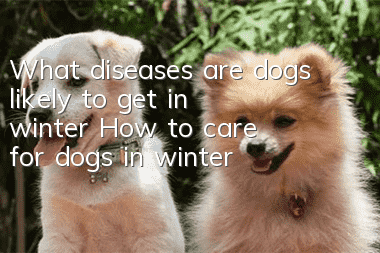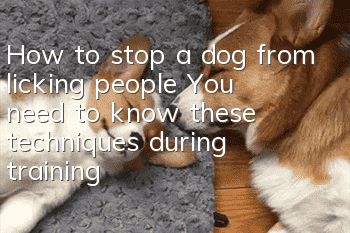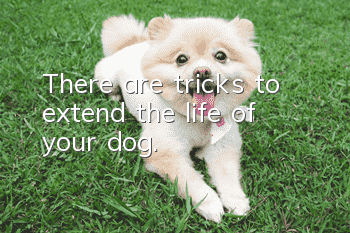What diseases are dogs likely to get in winter? How to care for dogs in winter

Canine infectious hepatitis
Route of infection: infection through the digestive tract.
Symptoms of onset: Acute cases include depression, chills, body temperature rising to about 40.5°C, loss of appetite, craving for water, vomiting, diarrhea and other symptoms. In the later stage of acute symptoms, anemia, jaundice, pharyngitis, tonsillitis, and swollen lymph nodes can be seen; characteristic symptoms are also manifested in the eyes, with corneal turbidity turning blue, corneal and conjunctival edema, half-closed eyes, and a large amount of fluid. Serous discharge.
Canine Adenovirus
Symptoms of onset: incubation period 5-6 days, persistent fever. Serous rhinorrhea from the nose can cause watery nasal fluid to be sprayed out with breathing. After 6-7 days, paroxysmal dry cough appeared, and later it became wet cough, shortness of breath, gong sound on tracheal auscultation, and oral examination showed swollen tonsils and red and swollen pharynx. As the disease progresses, it can lead to necrotizing pneumonia. Sick dogs show depression, not eating, and vomiting. The disease is often easily mixed with canine distemper and other respiratory diseases. Dogs with mixed infections often pose great difficulties in treatment and have a high mortality rate.
Coronavirus
Infection route: contact with sick dogs, infection through respiratory tract and digestive tract.
Symptoms of onset: frequent vomiting, diarrhea, anorexia, depression, dehydration and other symptoms. The incubation period is 1-3 days. Sick dogs exhibit lethargy, weakness, and anorexia. In the early stage, vomiting can last for several days, followed by diarrhea, dilute or watery stools, sometimes mixed with mucus and a small amount of blood in the stools. The dogs show high dehydration, sunken eyeballs, large skin elasticity, rapid weight loss, and slenderness.
Knowledge about dog health care in winter
Protection from cold and warmth
The first thing to pay attention to in winter is to keep cold and warm, because colds can be caused after exercising, being exposed to rain and wind, and the humidity in the dog's home. In severe cases, respiratory diseases such as bronchitis and pneumonia may occur. It’s urgent to protect yourself from the cold. Dog parents should place the kennel away from the wind, keep the kennel dry, and do not let pets spend the night outdoors. For short-haired puppies, the bedding inside the kennel should be thickened.
Exercise regularly
Don’t let your dog stay at home and sleep all the time. On sunny days, you should often take your dog out to play, run, jump and other sports. Exercise not only helps to improve the dog's immunity, but also increases fat burning and reduces fat accumulation caused by overeating fatty foods in winter. Dogs who exercise are energetic and healthy.
Nutritional balance
Being nutritious doesn't mean you need supplements. In winter, when the temperature is low, dogs will consume a lot of energy. Normal dietary standards cannot meet the needs. Therefore, while providing adequate protein foods, we should also provide high-energy foods such as corn and rice. When necessary, addAnimal and vegetable oils, such as broth or bone broth. Vitamins should also be supplemented. The dog's body is strong and can resist cold and reduce the occurrence of diseases.
Environmental Hygiene
The dog's home should be ventilated and kept clean at all times. The puppy should develop a good habit of defecating and avoid the habit of peeing and defecating in the den. A good environment can allow the dog to gain an extraordinary mental outlook and also Can reduce the occurrence of diseases.
Dry cleaning is required for bathing
It is the preference of many dog parents and parents to bathe their dogs frequently, but in winter, the frequency of bathing should be appropriately reduced. Pay attention to techniques when bathing. Partial cleaning or dry cleaning is the best way to bathe dogs in winter. It is best to do it in a sunny environment. Keep warm after washing to prevent colds.
Home Furnishing
In autumn, especially winter, there are fewer windows in the house than before. But whether it's for human health or dog health, it's good to open windows and ventilate your home some time each day. In addition, long-haired dogs are also preparing their bodies for cold protection during this season. The body hair increases and is easy to be driven away in groups, so they often need to be groomed. Grooming improves blood circulation. For dogs, it's like a massage. Brushing your dog's hair for a few minutes every day is good for your dog. It's also good to comb your dog's coat on a comb. This is a great way to prevent dog hair from flying around your home.
Travel
As the weather gets cooler, it’s also the season when dogs are prone to catching colds. Most dogs are not too afraid of the cold and do not need to wear clothes when going out. However, some breeds are smaller and do not have thick fur to keep them warm, such as Chihuahuas and fawns. It is still necessary to wear some clothes. If you encounter autumn rain or winter rain, it is the most likely time for dogs to catch a cold. It is best to wear a raincoat when your dog goes out. If you don’t have one, you will have to go out in the rain. If you come back, you must be well-insulated. Dry the dog as much as possible, or blow dry it, and let it rest in a warm room. If it has some cold symptoms, you can give it some cold medicine, just in case.
- How to prick up your dog’s ears with tape Super simple process for pricking up your dog’s ears
- What should dogs eat when they are recovering from parvovirus? What should dogs eat during their recovery period from parvovirus?
- Advantages of Corgis Short-legged Corgis have so many advantages!
- How to care for Bull Terrier ears to keep your dog’s ears healthy
- How to recover from nerve damage in dogs How long does it take for dogs to recover from nerve damage
- Postpartum care for female dogs: these points owners must know
- Can dogs have a SPA? What are the benefits of giving dogs a SPA?
- Precautions for dog cleaning and care: several things owners must know
- What should you do to protect your dog’s food? Violence will only backfire.
- Raw bone and meat feeding method teaches you how to regulate the intestines and stomach of dogs



